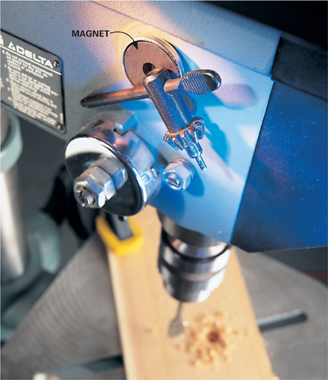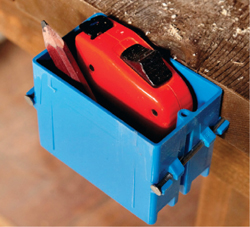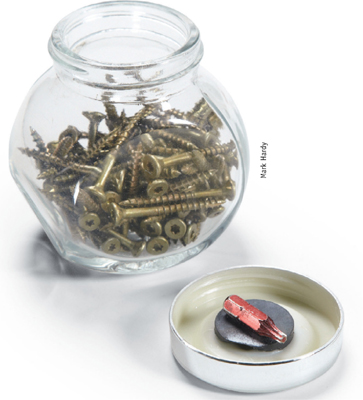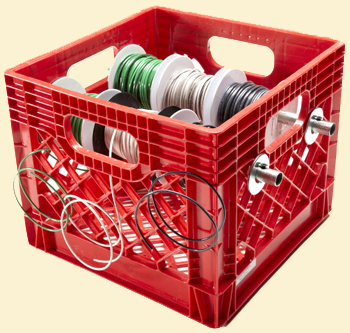Shop organizing tips
from our Editors and readers
Bucket-lid blade holder

I got tired of my extra saw blades banging around in the drawer every time I opened it, so I attached them to a 5-gallon bucket lid with a bolt and a thumbscrew. Now they stay put, and the lid protects my hands when I’m digging around for other stuff.

Mark Petersen TFH Contributing Editor
A safe chuck key holder

I used to hang the chuck key for my drill press on a string taped to the press. That worked well until the day I bumped it and the string caught the moving chuck and sent it flying. Luckily, it left an indentation in the wall instead of in me. Now I use a magnet to keep the chuck key handy—lesson learned.

Travis Larson TFH Senior Editor
Tape measures always within reach

I have a dozen tape measures, but there was never one around when I needed it. So I bought a bunch of electrical junction boxes and nailed them up in strategic locations—next to the miter saw, the table saw, on my workbench, in the garden shed—and put a tape measure and pencil in each one. No more searching for a tape in the middle of a project.
Gary Wentz, TFH Senior Editor
Build shallow drawers

I have a pretty organized shop with lots of drawers, and here’s my tip. If you’re going to build drawers, build lots of shallow ones and very few deep ones. Here’s why. Just about everything you store for a shop is fairly thin—hand tools, blades, fasteners, sandpaper, etc. If you have a ton of shallow drawers, you can dedicate each one by category. Plus, it’s easier to find what you need when it’s not buried under 8 inches of other junk in the same drawer.
Travis Larson, TFH Senior Editor
Keep track of screw bits
It’s common now for a box of screws to include a bit—for star or Torx heads, for example. But small bits always seem to disappear just when you need them. So next time you buy a box of screws, store them in a glass jar and glue a magnet to the inside of the lid. The magnet holds the bit, and you don’t have to dump out all the screws to find it.

Extension cord smarts
To prevent tangled extension cords, use hook-and-loop tape to keep long cords organized. Wind the cord in 10-ft. loops and wrap each coil with hook-and-loop tape. That way you can easily unwrap only what you need for a given job. It keeps the work site safer and you don’t have to unwind and rewind 50 ft. of cord when you only need 11.

Sheet metal drawer liners
If you’re one of those guys who uses old kitchen cabinets in your workshop, here’s a tip for you. It’s a bad idea to throw oily, greasy tools into those drawers, where the wood soaks up everything. Instead, take some careful measurements of the width, depth and height to any HVAC shop. For about $20 per drawer, you can get custom liners for each one. The interiors will look like new, and you’ll be able to clean them as needed.











